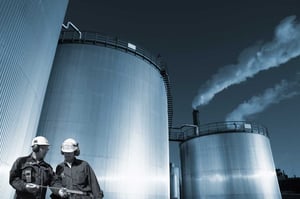
The EPA recently terminated its support of TANKS 4.09D Software program for tanks calculations, leaving facilities that relied on the tool in the lurch All facilities must now transition away from TANKS 4.09D and find a replacements tanks software to calculate their storage tank emissions. TANKS 4.09 was eventually bogged down by its many limitations when it came to addressing a full range of tank types and tank processes, underscoring the complexity of tank emissions calculations for the average business. This article explains the fall of TANKS 4.09, why it went defunct, what you need to know about it, and what you can to upgrade or replace your tank emissions software.
Why EPA Needed to Discontinue TANKS 4.09DTank EHS management is very complex, with so many factors and scenarios to keep in mind when measuring emissions. Each of the physical characteristics of your tank(s) has a numerically significant impact on the total emissions generated. Building and maintaining a system that accounts for all types of tanks is not simply a matter of understanding the science (which the EPA did) but is also a question being able to scale and maintain an extraordinary multitude of variables in the program’s logic. For that reason, EPA TANKS software was forced to compromise in the number of different tank types it could handle – if your tanks were included in that list then TANKS 4.09D could work for you, but otherwise you were left stranded. Eventually, EPA realized that it was not feasible to continue to maintain the back-end logic or database structures needed to keep up with the industry.
Today, if you refer back to the EPA’s official website and documentation on TANKS 4.09D (https://www3.epa.gov/ttnchie1/software/tanks/) you’ll see the message is loud and clear: TANKS became too clunky and unreliable as a software program to support long-term. The latest stable build of TANKS was released in 2005, and has not undergone any program core updates since, making it incompatible with nearly all the computing technology used today by tank owners and operators. At this moment, EPA advises “The TANKS model was developed using a software that is now outdated. Because of this, the model is not reliably functional on computers using certain operating systems such as Windows Vista or Windows 7. We are anticipating that additional problems will arise as PCs switch to the other operating systems. Therefore, we can no longer provide assistance to users of TANKs 4.09d.”
What’s also clear in the EPA’s missive is that the science behind TANKS – AP-42 Chapter 7 should still be used as the standard for tank emission calculations. So, it’s not that the science of TANKS was incorrect, just that the software couldn’t live up to the rigorous demands of the industry.
Tank Types and How to Automate AP-42 Chapter 7
Without EPA TANKS software to crunch the numbers for you according to AP-42 Chapter 7 guidelines, you’re left with the choice to work through the calculations manually or to find a reliable TANKS replacement software.
Since the scale/magnitude of tank types was one of the limiting factors for TANKS, one of the first things to look out for is a solution that is already stable and able to address a full range of tank types. For greater accuracy, we suggest using a software to calculate instead of storing your tank parameter data & chemical data using spreadsheet formulas. The best practice for tank emissions is to use a software tool that can capture the varying scenarios for your tanks and processes. This means ensuring whatever tool you use can give you coverage for:
- Open top / closed top
- Vertical / horizontal
- Floating roof / fixed roof
- Heated, Hot, Mixing, Storage
Start with an inventory of all the types of tanks you use across your entire organization, and then drill down to smaller details like tank color, tank material, and the other tank physical properties laid out in AP-42 Chapter 7.
Because it has been built following these exacting AP-42 standards, ERA Environmental Tanks software is able to cover more tank types than TANKS 4.09D, as well as the full range of tank emissions types and events, ensuring greater accuracy for your calculations. We’ve been specializing in Big Data management systems and database structures for EHS for over two decades, allowing us to fully support and maintain a software program of this scale.
ERA calculates using the physical tank structure, atmospheric conditions, stored contents, and the geographical distribution of your organization’s tanks. All the important complex variables are calculated to best match your operations. This directly facilitates the reporting of TRI and Tier II, as well as covering speciated chemical emissions.
Regulatory Updates Built In
Because industry regulations are updated so often, find a software option guarantees regulatory support and updates to ensure your success. Any changes to calculations, emission factors, or regulations should be incorporated into your software on a regular basis.
Part of what contributed to the eventual downfall of EPA TANKS 4.09D was the requirement to maintain both the software’s systems engine and the regulatory engine that powered the calculations. In the release notes for the latest stable build, EPA published the following caveat:
“One of the errors in TANKS is that it uses annual average liquid bulk temperature when computing monthly emissions rather than calculating a monthly liquid bulk temperature. Since TANKS uses annual average liquid bulk temperature in the monthly calculations, a change in the temperature for one month will affect every month, in that changing one month changes the annual average. As such, the TANKS program will NOT adequately account for the monthly variations.”
EPA was not able to dedicate the resources to keep TANKS compatible with new updates to the calculations and science, limiting the ways that TANKS could be used reliably. What this means for you as a tank owner/operator is that whatever tool you use it needs to be constantly monitored and updated for any and all regulatory updates. A “static” tanks software will very soon become obsolete, so seek out a TANKS replacement that emphasizes being built on a live service.
The very best tank emissions software handles all the regulatory research and updates for you helping your EH&S team can perform with efficiency and accuracy. At ERA, we enlist a team of regulatory researchers to incorporate regulatory updates in the Tanks Software and notify you of any important change. We also want users to trust that the ERA Tanks Software can deliver outputs and reports in a format that is compatible with any regulatory specifications. ERA ensures optimal reporting capacity with regulatory e-reporting tools ranging from TRI, Tier II, and other Tank-specific reports.
Tank Software Should Explore More than Calculations
EPA TANKS was a purpose-built reporting tool that had a narrow focus on EPA compliance reporting. Now that’s fine as a base line, but facilities with tanks know that there’s a lot more that goes into managing your environmental compliance and tank operations that just a VOC report.
Tanks calculation software can be used for more than just bare-bones regulatory compliance. Key insights into your Tanks operations can allow your facility to form benchmarking, improvements, and voluntary internal/external reporting. These programs rely on having reliable data about your emissions at any given moment.
For example, you could monitor your tank emissions on a weekly or monthly basis in just minutes in order to measure your environmental impact or examine trends in output. Some businesses might choose then to include this tracking in a quarterly shareholder’s report or annual public sustainability report. You can also use a software that models your tanks virtually to quickly forecast the effects of introducing a different material into your tanks on your GLC and other reporting requirements.
Another major area of concern for Oil & Gas facilities with large tank farms and pipelines is the ability to connect your tank emissions software reporting to LDAR (Leak Detection and Repair) processes and equipment. Your operation’s full fugitive emissions reporting needs to account for working losses, standing losses, and accidental leaks from pipes and tanks – and if you’re putting all these emission data points into silos instead of putting them in communication, you’re not seeing the whole picture.
The Ease of Automation
There are some emission source calculations than can be calculated by hand, but tanks are not among that group. A single tank can require many different variables, meaning that estimating emissions from one tank containing one type of material over the reporting period can take a great deal of time and cross referencing against industry literature and AP-42.
With Tanks Emissions Software, your facility can better determine emissions from an entire battery of tanks for a desired reporting period within a few minutes. Using software to reference all emission factors, chemical data, temperature data, and tank type-related factors automatically within seconds, your facility can automatically take credits to the Emission Inventory for all of the control technologies you utilize onsite with accuracy that outclasses TANKS 4.09D.
Do I Need to Stop Using EPA TANKS 4.09D?
The long and the short of it is yes. The EPA is very clear in its statements that TANKS 4.09D is no longer supported by the agency, in addition to the fact that EPA no longer considers most data generated by TANKS to be fully accurate or reliable. EPA even cautions that the current models available online of TANKS should be used at your discretion and risk.
“The model will remain on the website to be used at your discretion and at your own risk. We will continue to recommend the use of the equations/algorithms specified in AP-42 Chapter 7 for estimating VOC emissions from storage tanks. The equations specified in AP-42 Chapter 7”
So, what’s the answer? On a foundational level, the EPA stands by the AP-42 Chapter 7 equations and says that all submitted data should follow those guidelines. For most tank owners and operators, the scale of their operations makes using a software a necessity, leaving them with the following criteria as a guidepost:
- Select a tank emissions software that is based on the AP-42 calculations.
- Choose a service provider / developer that has invested in live and ongoing regulatory updates.
- Verify that your software of choice can handle all the necessary tank types and operations you need.
- Avoid programs that force you to silo different types of operational / emissions data apart from each other.
- Ask for a complete register of emission reports that the software can generate and make sure yours are on that list.
Learn the Science Behind Tank Calculations and Become a Tanks Pro
If tank emissions are part of your EHS portfolio, you need to know the mathematics and calculations behind the final report. AP-42 Chapter 7 is recognized as an industry standard, but it’s also notoriously complex and difficult to understand. That’s why we’ve compiled and summarized the core of AP-42 into a simple and digestible reference PDF document that gets straight to the point of storage tank emissions. It’s free and available on demand. Get yours today.
This Blog Was Co-Authored By:


Tags:
Environmental Management
October 29, 2019

Comments